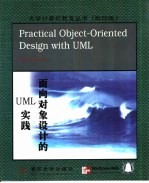

面向对象设计的 UML 实践 英文PDF电子书下载
- 电子书积分:12 积分如何计算积分?
- 作 者:(美)Mark Priestley
- 出 版 社:北京:清华大学出版社
- 出版年份:2000
- ISBN:7302040982
- 页数:338 页
1 Introduction to UML 1
1.1Models and modelling 1
1.2Methodologies 5
1.3The unified Modeling Language 7
1.4Design models and code 10
1.5The software development process 12
1.6Summary 13
1.7Exercises 13
2.1The object model 15
2 Modelling with Objects 15
2.2Objects 17
2.3Objects properties 19
2.4Avoiding data replication 21
2.5Links 21
2.6Message passing 25
2.7Polymorphism 27
2.8Dynamic binding 30
2.9Class diagrams 31
2.10The applicability of the object model 33
2.11Summary 34
2.12Exercises 35
3 Diagram Editor : Use Case View 38
3.1 Statement of requirements 38
3.2 The use case view 40
3.3 Creating new diagrams 43
3.4 Use case realization 44
3.5 Creating new elements 46
3.6 Selecting elements 51
3.7 Deleting elements 54
3.8 Moving and resizinge lements 55
3.9 Use case extension 58
3.10 Use case diagrams 60
3.11 Summary 61
3.12 Exercises 62
4 Diagram Editor: Design View 65
4.1 The role of the design view 65
4.2 Classes and associations 66
4.3 Generalization 70
4.4 Creation tools 72
4.5 Selection tools 73
4.6 Features of classes 75
4.7 Complete class diagram 76
4.8 Dynamic modelling of the diagram editor 77
4.9 A statechart for creation tools 79
4.10 A statechart for selection tools 82
4.11 Statecharts of other classes 84
4.12 Summary 85
4.13 Exercises 85
5 Diagram Editor: Implementation View 88
5.1 Application frameworks 88
5.2 The applet framework 92
5.3 Implementation of classes 96
5.4 Implementation of associations 98
5.5 Implementation of statecharts 102
5.6 Managing tools 105
5.7 The document/view architecture 106
5.8 Summary 108
5.9 Exercises 109
6 Class Diagrams 111
6.1 Primitive notions 112
6.2 Classes 114
6.3 Describing objects with classes 115
6.4 Associations 119
6.5 The need for generalization 125
6.6 Generalization and specialization 126
6.7 Inheritance of attributes and operations 129
6.8 Association generalization 133
6.9 Aggregation 135
6.10 Composite objects 138
6.11 Association classes 140
6.12 Qualified associations 144
6.13 Multiple inheritance 146
6.14 Summary 150
6.15 Exercises 152
7.1 Collaborations 160
7 Interaction Diagrams 160
7.2 Classifier roles 162
7.3 Association roles 163
7.4 Transient links 163
7.5 Interaction diagrams 164
7.6 Object creation 168
7.7 Object destruction 169
7.8 Iterated messages 170
7.9 Multiobjects 171
7.10 Conditional messages 173
7.11 Messages of self 176
7.12 Summary 177
7.13 Exercises 178
8 Statecharts 180
8.1 State-dependent behaviour 181
8.2 States,events and transitions 182
8.3 Initial and final states 183
8.4 Guard conditions 184
8.5 Actions 186
8.6 Activities 188
8.7 Composite states 190
8.8 History states 193
8.9 Summary of the CD player 194
8.10 Dynamic modelling in practice 195
8.11 Time events 200
8.12 Activity states 200
8.13 Summary of the ticket machine 201
8.14 Summary 201
8.15 Exercises 203
9 Constraints 207
9.1 Standard constraints 208
9.2 The Object Constraint Language 209
9.3 The context of a constraint 210
9.4 Navigation expressions 211
9.5 Objects and collections 214
9.6 Constraints 218
9.7 Stereotyped constraints 221
9.8 Constraints and generalization 223
9.9 Summary 224
9.10 Exercises 225
10 Implementation Strategies 227
10.1 Implementing associations 228
10.2 Unidirectional implementations 229
10.3 Bidirectional implementations 232
10.4 Implementing qualifiers 238
10.5 Implementing associations as classes 240
10.6 Implementing constraints 242
10.7 Implementing statecharts 243
10.8 Persitency 247
10.9 Interfacing to databases 249
10.10 Summary 252
10.11 Exercises 253
11 Design pragmatics 254
11.1 Physical design 255
11.2 Interfaces 260
11.3 Reverse engineering 261
11.4 Templates 264
11.5 Optimization of design models 265
11.6 Summary 270
11.7 Exercises 271
12 Principles and Patterns 272
12.1 The open-closed principle 273
12.2 No concrete superclasses 277
12.3 Decouple the interface hierarchy 279
12.4 The Liskov substitution principle 281
12.5 Interactions determine structure 282
12.6 Design patterns 284
12.7 Recursive structures 286
12.8 The State and Strategy pattems 290
12.9 MVC, document/view and Observer 291
12.10 Applying Visitor to the stock control program 294
12.11 Summary 298
12.12 Exercises 298
13 Cab Dispatching System 300
13.1 Use cases 300
13.2 handing immediate jobs 301
13.3 Handing prebooked jobs 307
13.4 Allocating a cab to a job 309
13.5 Job confirmation 312
13.6 Cancelling a job 315
13.7 Progression of jobs 316
13.8 Completing the static model 317
13.9 Implementation overview 318
13.10 Summary 321
13.11 Exercises 322
A Summary of Notation Used 323
A.1 Common notations 323
A.2 Use case diagrams 325
A.3 Object diagrams 326
A.4 Collaborations 326
A.5 Sequence diagrams 327
A.6 Collaboration diagrams 328
A.7 Class diagrams 329
A.8 Statechart diagrams 331
A.9 Component diagrams 332
A.10 Templates 332
References 334
Index 336
- 《指向核心素养 北京十一学校名师教学设计 英语 七年级 上 配人教版》周志英总主编 2019
- 《设计十六日 国内外美术院校报考攻略》沈海泯著 2018
- 《计算机辅助平面设计》吴轶博主编 2019
- 《语文教育教学实践探索》陈德收 2018
- 《彼得·布鲁克导演实践研究》邓小玲著 2019
- 《高校转型发展系列教材 素描基础与设计》施猛责任编辑;(中国)魏伏一,徐红 2019
- 《景观艺术设计》林春水,马俊 2019
- 《反思性实践》胡红梅, 2019
- 《高含硫气藏开发腐蚀控制技术与实践》唐永帆,张强 2018
- 《高等教育双机械基础课程系列教材 高等学校教材 机械设计课程设计手册 第5版》吴宗泽,罗圣国,高志,李威 2018
- 《SQL与关系数据库理论》(美)戴特(C.J.Date) 2019
- 《魔法销售台词》(美)埃尔默·惠勒著 2019
- 《看漫画学钢琴 技巧 3》高宁译;(日)川崎美雪 2019
- 《优势谈判 15周年经典版》(美)罗杰·道森 2018
- 《社会学与人类生活 社会问题解析 第11版》(美)James M. Henslin(詹姆斯·M. 汉斯林) 2019
- 《海明威书信集:1917-1961 下》(美)海明威(Ernest Hemingway)著;潘小松译 2019
- 《迁徙 默温自选诗集 上》(美)W.S.默温著;伽禾译 2020
- 《上帝的孤独者 下 托马斯·沃尔夫短篇小说集》(美)托马斯·沃尔夫著;刘积源译 2017
- 《巴黎永远没个完》(美)海明威著 2017
- 《剑桥国际英语写作教程 段落写作》(美)吉尔·辛格尔顿(Jill Shingleton)编著 2019
- 《大学计算机实验指导及习题解答》曹成志,宋长龙 2019
- 《指向核心素养 北京十一学校名师教学设计 英语 七年级 上 配人教版》周志英总主编 2019
- 《大学生心理健康与人生发展》王琳责任编辑;(中国)肖宇 2019
- 《大学英语四级考试全真试题 标准模拟 四级》汪开虎主编 2012
- 《大学英语教学的跨文化交际视角研究与创新发展》许丽云,刘枫,尚利明著 2020
- 《北京生态环境保护》《北京环境保护丛书》编委会编著 2018
- 《复旦大学新闻学院教授学术丛书 新闻实务随想录》刘海贵 2019
- 《大学英语综合教程 1》王佃春,骆敏主编 2015
- 《大学物理简明教程 下 第2版》施卫主编 2020
- 《指向核心素养 北京十一学校名师教学设计 英语 九年级 上 配人教版》周志英总主编 2019
